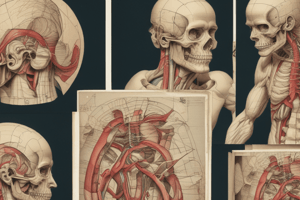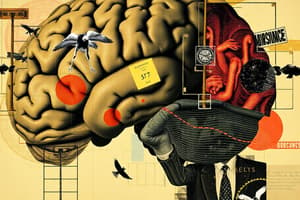Podcast
Questions and Answers
What primarily characterizes the origin of extrapyramidal tracts?
What primarily characterizes the origin of extrapyramidal tracts?
- Originates only from the cortex.
- Originates solely from subcortical structures.
- Originates from both cortical and subcortical areas. (correct)
- Originates exclusively from brainstem regions.
Which of the following statements is true regarding the functions of pyramidal tracts?
Which of the following statements is true regarding the functions of pyramidal tracts?
- They inhibit muscle tone during movements.
- They primarily control gross movements.
- They are active during the first year of life.
- They facilitate the muscle tone. (correct)
What is the crossing fiber percentage for extrapyramidal tracts?
What is the crossing fiber percentage for extrapyramidal tracts?
- Less than 30%.
- About 70%.
- Roughly 50%. (correct)
- Approximately 90%.
Which of the following correctly describes the lesions affecting both pyramidal and extrapyramidal tracts?
Which of the following correctly describes the lesions affecting both pyramidal and extrapyramidal tracts?
During which part of development do extrapyramidal functions typically begin?
During which part of development do extrapyramidal functions typically begin?
What is the primary function of the lateral tract of the pyramidal tract?
What is the primary function of the lateral tract of the pyramidal tract?
Which statement accurately describes the innervation of cranial nerve nuclei?
Which statement accurately describes the innervation of cranial nerve nuclei?
What is true regarding myelination in the pyramidal tract?
What is true regarding myelination in the pyramidal tract?
Which function is not attributed to the pyramidal tract?
Which function is not attributed to the pyramidal tract?
Which area of the brain is involved in regulating conjugate eye movements through the corticobulbar tract?
Which area of the brain is involved in regulating conjugate eye movements through the corticobulbar tract?
Flashcards are hidden until you start studying
Study Notes
### Pyramidal and Extrapyramidal Tracts
- Pyramidal tracts originate from the cortex and consist of a single neuron pathway.
- More than 90% of pyramidal tract fibers cross, terminating in Alpha and Gamma motor neurons of cranial nerve nuclei and spinal cord.
- Pyramidal tracts control fine skilled movements and facilitate muscle tone.
- Extrapyramidal tracts have a wider origin, including cortical and subcortical areas.
- Extrapyramidal tracts involve multiple neurons and synapses, and approximately 50% of fibers cross.
- Extrapyramidal tracts terminate in Alpha and Gamma motor neurons of the spinal cord but not cranial nerve nuclei.
- Extrapyramidal tracts control gross and associated movements, and can inhibit or facilitate muscle tone.
### Medial Brain Stem Pathways
- Medial brain stem pathways work with the ventral corticospinal tract and include the pontine and medullary reticulospinal tracts, vestibulospinal tracts, and tectospinal tracts.
- These pathways predominantly terminate on interneurons within the ventral horn of the spinal cord.
- The medial brain stem pathways play a primary role in controlling axial and proximal muscles.
- Figure 3.40 illustrates the medial and lateral brain stem pathways, highlighting their locations, connections, and target regions.
- Areas shown in the diagram include the red nucleus, tectum, medial reticular formation, and lateral and medial vestibular nuclei.
Motor System and its Neurons
- The motor system relies on two types of neurons:
- Upper Motor Neurons (UMNs) originate in the cerebral cortex and terminate in the spinal cord or brain stem
- Lower Motor Neurons (LMNs) originate in the anterior horn cells (AHCs) of the spinal cord and terminate at skeletal muscles or in the brain stem for facial and eye muscles
Pyramidal Tract
- A well-developed tract in humans connecting the motor cortex to the AHCs or cranial nerve nuclei
- Consists of approximately one million fibers, with about 60% being myelinated
- Myelination is complete after one year of age
- Some fibers originate from pyramidal (Betz) cells in motor area 4
Corticobulbar Tract
- Innervates the facial nucleus (cranial nerve VII)
- Diagram showing the upper and lower face innervation
Functions of the Pyramidal Tract
- Lateral Tract: controls fine skilled movements, especially in distal joints, examples include writing, typing, and playing musical instruments
- Ventral Tract: shares responsibility with the extrapyramidal tract for controlling gross movements and postural adjustments to support skilled movement performance
- Uncrossed: innervates abdominal and respiratory muscles
- Facilitatory: enhances superficial and deep reflexes
- Inhibitory: suppresses primitive withdrawal reflexes (Babinski's sign)
- The corticobulbar tract, originating from the frontal eye field area (area 8), regulates conjugate eye movements
Studying That Suits You
Use AI to generate personalized quizzes and flashcards to suit your learning preferences.



